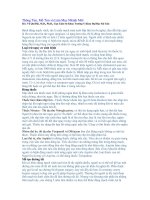TÀI LIỆU SA TIM THAI
Bạn đang xem bản rút gọn của tài liệu. Xem và tải ngay bản đầy đủ của tài liệu tại đây (4.59 MB, 58 trang )
Dr. Tin Phan
Da Nang, 6/16/09
INTRODUCTION
Pulsed and color Doppler ultrasound improve the diagnostic
accuracy of twodimensional gray-scale imaging in the
prenatal detection of abnormalities of the heart and great
arteries. The two methods are complementary to each other,
with color Doppler being used for general assessment of flow
in the region of interest and pulsed Doppler for targeted
examination of flow in a vessel or across a valve 1–10.
In pulsed Doppler ultrasound, the examiner positions a sample
volume over the region of interest to obtain flow velocity
waveforms as a function of time. This makes it possible to
quantify blood flow as peak or time-averaged mean velocities,
which allow the calculation of ratios (such as the E/A ratio) or
blood volume (such as stroke volume or cardiac output) after
measurement of vessel diameter. Color Doppler, which is
technically easier to perform, allows a rapid assessment of
the hemodynamic situation, but gives only descriptive or
semi-quantitative information on blood flow.
EXAMINATION OF THE NORMAL HEART
Examination of the fetal heart using color Doppler including the
abdominal view, four-chamber view, five-chamber view, the
short-axis and the three-vessel view need to be assessed to
achieve spatial information on different cardiac chambers and
vessels as well as their connections to each other 1,2,4. The
difference from two-dimensional scanning is that, with color
Doppler, the angle of insonation should be as small as
possible
for
optimal
visualization
of
flow.
In the abdominal plane, the position of the aorta, inferior
vena cava and the connection of the vein to the right atrium
are examined. Pulsed Doppler sampling from the inferior vena
cava, the ductus venosus or the hepatic veins can be
achieved in longitudinal planes.
EXAMINATION OF THE NORMAL HEART
The four-chamber view allows the detection of many severe cardiac
defects. Using color Doppler in an apical (Figure 1) or basal approach,
the diastolic perfusion across the atrioventricular valves can be assessed;
there is a characteristic separate perfusion of both inflow tracts during
diastole (Figure 1). Using pulsed Doppler, there is a typical biphasic
shape of the diastolic flow velocity waveform with an early peak diastolic
velocity (E) and a second peak during atrial contraction (A-wave); E is
smaller than A, and the E : A ratio increases during pregnancy toward 1,
to be inversed after birth. In this plane, regurgitation across the
atrioventricular valves, which is more frequent at the tricuspid valve, is
easily detected during systole with color Doppler. Flow across the
foramen ovale is visualized in a lateral approach of the four-chamber
view. Color Doppler allows confirmation of the physiological right-to-left
shunt and visualization of the pulmonary veins as they enter the left
atrium.
Figure 1: Four-chamber view in real-time (left) and color Doppler. During
diastole, flow is visualized entering from both the right and left atria (RA,
LA) into the right and left ventricles (RV, LV) and the flows are separated
by the interatrial and interventricular septum.
Figure 2: Five-chamber view in real-time (left) using color Doppler (right).
The aorta, arising from the left ventricle, is seen and color shows the
laminar flow across the aortic valve during systole. Compare with aortic
stenosis (Figure 7) and overriding aorta (Figure 12).
Figure 3: Five-chamber view in real-time (left) using color Doppler (right).
The pulmonar vein, arising from the right ventricle.
Figure 4: (a,b) Aortic Arch; (c) color doppler angio of the aortic arch
Figure 6: (a,b) Venous return (IVC & SVC); (c) color doppler
angio of the venous return
Figure 7: Three-dimensional power Doppler ultrasound of the crossing of
the great vessels in a 28-week fetus. AOA, aortic arch; DA, ductus
arteriosus; LPA, left pulmonary artery; TP, pulmonary trunk
Figure 8: Tricuspid atresia (*) and ventricular septal defect (VSD).
Arrows show the direction of flow; due to the atresia of the tricuspid
valve, blood entering the right atrium cannot enter directly into the right
ventricle and it flows to the left atrium, left ventricle and across the VSD
to the hypoplastic right ventricle (right).
EXAMINATION OF THE ABNORMAL HEART
Tricuspid atresia
In this condition, there is absence of the connection between the
right atrium and the right ventricle. In the four-chamber view,
the right ventricle is hypoplastic or absent and color Doppler
demonstrates the absence of flow from the right atrium to the
right ventricle (Figure 3). Blood from the right atrium flows
across the foramen ovale to the left atrium and from there
during diastole to the left ventricle. This unilateral perfusion
across the left ventricular inflow tract is typical for this lesion. In
the presence of an associated ventricular septal defect, a left-toright shunt into the small right ventricular cavity is found. The
postnatal prognosis depends on the anatomy of the great
vessels. The ventriculo–arterial connection can be concordant or
discordant, and the pulmonary valve can be patent, stenotic or
atretic; color Doppler helps in the reliable differentiation
between these conditions.
Figure 9: the right ventricle is hypoplastic or absent and color
Doppler demonstrates the absence or minimum flow from the right
atrium to the right ventricle.
Tricuspid dysplasia and Ebstein anomaly
In tricuspid dysplasia, the valve leaflets are correctly inserted
but they are thickened. By contrast, the valve leaflets in
Ebstein anomaly are inserted abnormally so that they are
more apical in the right ventricle and their ability to close is
reduced. In both conditions there is tricuspid regurgitation
which is generally associated with dilatation of the right
atrium and, in extreme forms, with gross cardiomegaly
(Figure 4) 11,12. Color Doppler is used to confirm tricuspid
regurgitation and spectral Doppler (Figure 5) is used to
measure the pressure gradient and duration of the
regurgitation. Since both anomalies are associated with an
obstruction of the right ventricular outflow tract (pulmonary
stenosis or atresia), it is mandatory to analyze the perfusion
in the pulmonary trunk. In severe obstruction, retrograde flow
within the ductus arteriosus is found (see Figure 6). This,
however, does not prove pulmonary atresia because a patent
but stenotic pulmonary valve, due to tricuspid regurgitation,
can show the same features as an atresia and thus leads to a
false-positive result12
Tricuspid dysplasia and Ebstein anomaly
Figure 10: The characteristic finding is that of a
massively enlarged right atrium, a small right ventricle,
and a small pulmonary artery. Doppler can be used to
demonstrate regurgitation in the right atrium
Pulmonary atresia and intact ventricular septum
The size and shape of the right ventricle show a wide range,
from hypoplastic to normal sized or even dilated. The latter
form is identical to tricuspid dysplasia with pulmonary atresia.
In both former types, the right ventricle shows no contractility
and the tricuspid valve movements are reduced. Color
Doppler in the four-chamber view shows absence or reduced
tricuspid flow and, during systole, there may be tricuspid
valve regurgitation. In the three-vessel view or the short-axis
view, there is absence of antegrade perfusion across the
pulmonary valve and retrograde flow through the ductus
arteriosus (Figure 6). The pulmonary trunk in these conditions
is narrower than the ascending aorta, but is not severely
hypoplastic because of retrograde perfusion through the
ductus arteriosus. In some hearts with pulmonary atresia,
communications between the hypoplastic right ventricle and
the coronary arteries may be present and are detectable by
color Doppler ultrasound13in mid-gestation. Their presence is
associated with worse neonatal outcome.
Figure 11: Tricuspid valve dysplasia with severe tricuspid insufficiency
and cardiomegaly. Retrograde flow from the right ventricle (RV) to the
right atrium (RA) is seen in blue and turbulence is coded by green pixels.
Figure 12: Severe tricuspid regurgitation. Pulsed wave Doppler (left)
is not useful due to the aliasing phenomenon and the maximal
velocities that can be assessed are 180 cm/s (arrow). The continuous
wave transducer allows assessment of very high velocities; in this case
420 cm/s
Figure 13: Hypoplastic right ventricle (arrow) in a fetus with
pulmonary atresia and intact ventricular septum (a). Color doppler of
the 4 chamber view with asymmetric flow between the left heart and
right heart. Pulmonary valve atresia can be diagnosed using color
Doppler by visualizing the great vessels – aorta (Ao) and pulmonary
trunk (TP) – in the upper thorax and demonstrating the retrograde
flow from the descending aorta across the ductus arteriosus toward
the pulmonary valve.
Pulmonary stenosis
In the isolated form of this lesion, there is narrowing of the
semilunar valves. In severe cases, a hypokinetic and
hypertrophied right ventricle can be found but most cases are
not detected prenatally. On two-dimensional imaging, the
diagnosis is suspected by the presence of poststenotic
dilatation of the pulmonary trunk and reduction of pulmonary
valve excursion. With color Doppler, the diagnosis is easy and
is based on the demonstration of turbulent flow across the
pulmonary valve. In severe cases, a retrograde flow can be
found through the ductus arteriosus. Doppler flow velocity
waveforms using a continuous wave transducer enable the
demonstration of high velocities (more than 2 m/s), which are
typical of stenosis. These findings, either in color or in pulsed
Doppler, are only typical of the isolated form and are not
commonly found in conditions associated with a ventricular
septal defect, such as tetralogy of Fallot or double outlet right
ventricle. Fetal pulmonary stenosis can be associated in the
third trimester with tricuspid insufficiency, leading in some
cases to right atrial dilatation8.
Aortic stenosis
In general, the narrowing is found at the level of the aortic valve and a
simple stenosis is rarely detected in the four-chamber view.
However, a critical aortic stenosis is associated with a dilated and
hypokinetic left ventricle with an echogenic endocardium, as a sign
of endocardial fibroelastosis. Simple aortic stenosis can be detected
only by using color Doppler (Figure 7). Antegrade turbulent flow
(aliasing) is a characteristic finding in the five-chamber view (Figure
7). Pulsed Doppler analysis shows high velocities (more than 2 m/s)
and a characteristic aliasing pattern. Continuous wave Doppler is
therefore necessary to confirm the diagnosis (Figure 7). In critical
aortic stenosis, there is antegrade turbulent flow across the aortic
valve, but peak systolic velocities can vary from more than 2 m/s to
values within the normal range, as an expression of left ventricular
dysfunction9. Due to the high pressure in the left ventricle, both a
mitral regurgitation and a left-to-right shunt at the level of the
foramen ovale are found8. In severe left ventricular dysfunction, a
retrograde flow is seen within the aortic arch.
Figure 14: Aortic stenosis with turbulent flow (green
pixels), as seen in the five-chamber view (compare with
normal findings in Figure 2). Continuous wave Doppler
allows a quantification of the stenosis.
Hydatidiform mole
It is a neoplastic
proliferation of
the trophoblast in
which the
terminal villi are
transformed into
vesicles filled
with clear viscid
material.
Gross
we see a mass of
vesicles, vary in size,
grape-like with stems,
blood and clot filling
the inter-vesicle space









